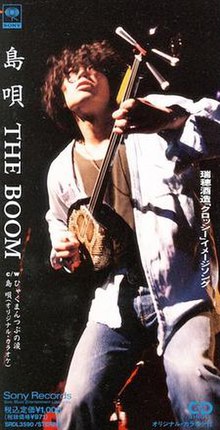Shima Uta (The Boom)
| "Shima Uta" | ||||
|---|---|---|---|---|

Cover of the "Uchinaaguchi Version"
|
||||
| Single by The Boom | ||||
| from the album Shisyunki | ||||
| A-side | "Shima Uta" | |||
| B-side | "Hyakuman Tsubu no Namida" | |||
| Released | December 12, 1992 (Uchinaaguchi Version) June 21, 1993 (Original Version) October 5, 2001 (2001 version) May 22, 2002 (Compilation single) March 20, 2013 (20th anniversary version) |
|||
| Format | 8cm single | |||
| Recorded | 1992 | |||
| Genre | Rock, min'yō | |||
| Length |
5:05 (Uchinaaguchi Version) 5:03 (Original Version) 6:18 (20th anniversary version) |
|||
| Songwriter(s) | Kazufumi Miyazawa | |||
| The Boom singles chronology | ||||
|
||||
| The Boom singles chronology | ||||
|
||||
| Alternate cover | ||||

Cover of the 1993 "Original Version"
|
||||
"Shima Uta" (島唄?, lit. "Island Song") is a 1992 song by the Japanese band The Boom. It was written by the lead singer, Kazufumi Miyazawa, based on his impressions from visiting Okinawa for a photo shoot. It is the band's best selling song, well known throughout Japan and Argentina, and one of the most widely known songs associated with Okinawa although the band members are all from Yamanashi Prefecture. The song uses a mix of modern pop and rock styles as well as min'yō. Okinawan musical instruments and Okinawan vocabulary have been incorporated into the song.
The song itself was used in an advertising campaign for the Xi brand awamori.
In a 2003 interview for fRoots, Miyazawa explained that he got the idea for the song after speaking with Okinawan survivors of the US invasion of Okinawa during World War II.
In another interview, Miyazawa explained that most Okinawan casualties were not caused by American troops, but by Japan's instructions to commit suicide rather than surrender.
While the song does not specify who the people being separated are, Miyazawa stated in the 2002 interview, "It is about the separation of a man and a woman, a separation that they couldn't control, and didn't want."
In fact, the term shima-uta originally refers to traditional folk songs of the Amami Islands. It is not a native term of Okinawa but was introduced from Amami in the 1970s. Uehara Naohiko, Okinawa's influential radio personality and songwriter, borrowed the term from Amami and give a new meaning to the term. He used his radio programs and musical events to popularized the name of shima-uta in Okinawa.
Miyazawa first heard Okinawan-influenced music from Haruomi Hosono in the 1970s. Later, he asked friends to bring him tapes from the island, as Okinawan music was not readily available in Japan. Miyazawa said in the 2003 interview,
...
Wikipedia
